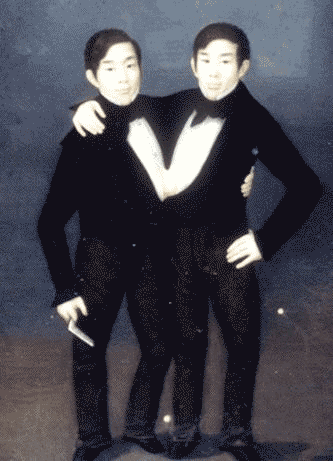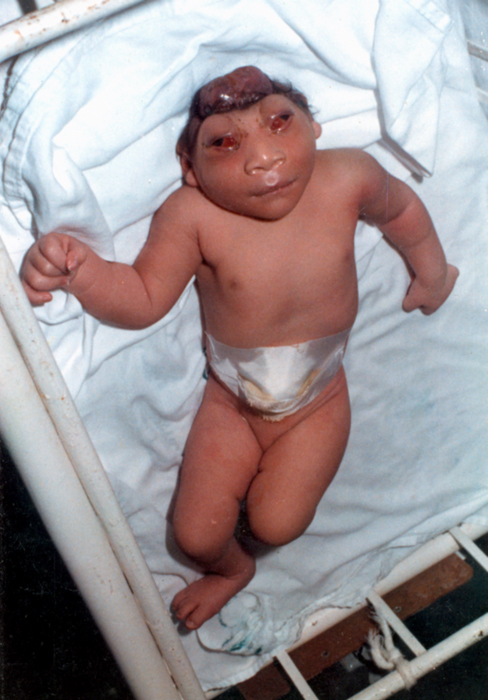|
Dicephalic Parapagus Twins
Skeletal structure of dicephalic twins. B. C. Hirst & G. A. Piersol, Human monstrosities. Wellcome L0027955. (1893) Dicephalic parapagus () is a rare form of partial twinning with two heads side by side on one torso. Infants conjoined this way are sometimes called "two-headed babies" in popular media. The condition is also called parapagus dicephalus. If carried to term, most dicephalic twins are stillborn, or die soon after birth. A small number are known to have survived to adulthood. The extent to which limbs and organs are duplicated varies from case to case. One head may be only partially developed ( anencephalic), or both may be complete. In some cases, two complete hearts are present as well, which improves their chances of survival. The total number of arms may be two, three or four. Their prospects are best if no attempt is made to separate them, except in cases in which one twin is clearly dying. Terminology Dicephalus means two-headed. Parapagus means joined sid ... [...More Info...] [...Related Items...] OR: [Wikipedia] [Google] [Baidu] |
Conjoined Twins
Conjoined twins – sometimes popularly referred to as Siamese twins – are twins joined '' in utero''. A very rare phenomenon, the occurrence is estimated to range from 1 in 49,000 births to 1 in 189,000 births, with a somewhat higher incidence in Southwest Asia and Africa. Approximately half are stillborn, and an additional one-third die within 24 hours. Most live births are female, with a ratio of 3:1. Two theories exist to explain the origins of conjoined twins. The more generally accepted theory is ''fission'', in which the fertilized egg splits partially. The other theory, no longer believed to be the basis of conjoined twinning, is ''fusion'', in which a fertilized egg completely separates, but stem cells (which search for similar cells) find similar stem cells on the other twin and fuse the twins together. Conjoined twins share a single common chorion, placenta, and amniotic sac, although these characteristics are not exclusive to conjoined twins, as there are some monozy ... [...More Info...] [...Related Items...] OR: [Wikipedia] [Google] [Baidu] |
Torso
The torso or trunk is an anatomical term for the central part, or the core, of the body of many animals (including humans), from which the head, neck The neck is the part of the body on many vertebrates that connects the head with the torso. The neck supports the weight of the head and protects the nerves that carry sensory and motor information from the brain down to the rest of the body. In ..., limb (anatomy), limbs, tail and other appendages extend. The tetrapod torso — including human body, that of a human — is usually divided into the ''chest, thoracic'' segment (also known as the upper torso, where the forelimbs extend), the ''abdomen, abdominal'' segment (also known as the "mid-section" or "midriff"), and the ''pelvic'' and ''perineum, perineal'' segments (sometimes known together with the abdomen as the lower torso, where the hindlimbs extend). Anatomy Major organs In humans, most critical Organ (anatomy), organs, with the notable exception of the brain, are ho ... [...More Info...] [...Related Items...] OR: [Wikipedia] [Google] [Baidu] |
Stillbirth
Stillbirth is typically defined as fetal death at or after 20 or 28 weeks of pregnancy, depending on the source. It results in a baby born without signs of life. A stillbirth can result in the feeling of guilt or grief in the mother. The term is in contrast to miscarriage, which is an early pregnancy loss, and Sudden Infant Death Syndrome, where the baby dies a short time after being born alive. Often the cause is unknown. Causes may include pregnancy complications such as pre-eclampsia and birth complications, problems with the placenta or umbilical cord, birth defects, infections such as malaria and syphilis, and poor health in the mother. Risk factors include a mother's age over 35, smoking, drug use, use of assisted reproductive technology, and first pregnancy. Stillbirth may be suspected when no fetal movement is felt. Confirmation is by ultrasound. Worldwide prevention of most stillbirths is possible with improved health systems. Around half of stillbirths oc ... [...More Info...] [...Related Items...] OR: [Wikipedia] [Google] [Baidu] |
Anencephalic
Anencephaly is the absence of a major portion of the brain, skull, and scalp that occurs during embryonic development. It is a cephalic disorder that results from a neural tube defect that occurs when the rostral (head) end of the neural tube fails to close, usually between the 23rd and 26th day following conception. Strictly speaking, the Greek term translates as "without a brain" (or totally lacking the inside part of the head), but it is accepted that children born with this disorder usually only lack a telencephalon, the largest part of the brain consisting mainly of the cerebral hemispheres, including the neocortex, which is responsible for cognition. The remaining structure is usually covered only by a thin layer of membrane—skin, bone, meninges, etc., are all lacking. With very few exceptions, infants with this disorder do not survive longer than a few hours or days after birth. Signs and symptoms The National Institute of Neurological Disorders and Stroke (NINDS) descri ... [...More Info...] [...Related Items...] OR: [Wikipedia] [Google] [Baidu] |
Giacomo And Giovanni Battista Tocci
Giacomo and Giovanni Battista Tocci were conjoined twins born in Locana, Italy between 1875 and 1877 in either July or October. They toured in a circus and retired about 1900; details of their later lives are uncertain. Birth Their mother Maria Luigia Mezzanrosa was 19 years old; she had an easy time with the birth as they were rather small. They were delivered normally, with one head appearing first, the other head and torso second, and the pelvis and legs third. The one on their right was named Giovanni Battista, and the one on their left Giacomo. They had one umbilical cord and one placenta. Their father Giovanni Tocci had a breakdown due to the appearance of his first-born sons and was put into a lunatic asylum until he recovered a month later. Early childhood The twins' parents did not allow any thorough examination of them as they believed it would diminish their fame. The twins' father took them to Turin to be exhibited in the freak show, where the twins wer ... [...More Info...] [...Related Items...] OR: [Wikipedia] [Google] [Baidu] |





